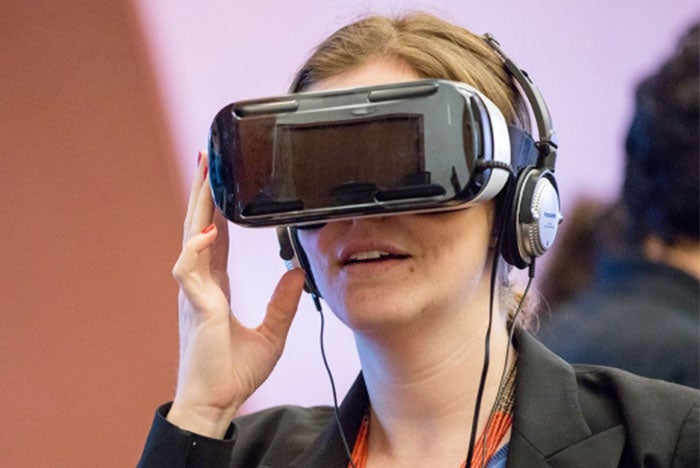Tech talk: Voice recognition, telehealth interpreters and children's health breakthroughs

Attendees of the Engineering for Children’s Health Symposium experimented with virtual-reality technology that can help in pain management for young patients.
Northern California engineers partner to improve Children’s health
University of California San Francisco, UCSF Benioff Children’s Hospital, Children’s Hospital Oakland Research Institute (CHORI) and University of California Berkeley have joined forces to form the Engineering for Children’s Health Initiative. Researchers, clinicians and engineers from across the Bay Area gathered last month for the group’s first annual symposium to discuss new technologies that can improve children’s health.
Many of the projects focused on improving safety and quality of care. For instance, the UCSF Clinical Innovations Center brought projectors into hospital rooms to transform bare walls into beautiful scenery, and it developed monitors that can detect delirium in overnight patients.
UCSF Benioff Children’s Hospital Oakland presented results from a pilot study in which it used virtual reality technology from the gaming world to mitigate pain in children with sickle cell disease. Fifteen-minute sessions in which children explore and interact with a calming underwater world full of dolphins, whales and rainbow-colored bubbles seems to reduce pain intensity by 16 percent.
Hanmin Lee, M.D., surgeon-in-chief at UCSF Benioff Children’s Hospital and co-director of the new initiative said he was inspired by the promise shown at the first symposium.
“We are poised to make advances at the intersection of biology and technology, and there is no greater mission than helping the most vulnerable populations worldwide, children and infants,” he says.
Voice-recognition helps patients at home to connect with doctors
Lenovo Health and Orbita are debuting a virtual home care solution at HIMSS 2017. The product combines Lenovo Smart Assistant and Orbita Voice for a dynamic solution for at-home patients to use natural voice-assistant technology to easily share information with members of their care team.
Lenovo's Smart Assistant is a voice-controlled speaker for the home that combines the power of the Amazon Alexa voice platform with Harman Kardon speaker technology. Orbita's Voice is a unique voice experience manager for health care that builds on the power of voice-assistant platforms like Amazon Alexa to enable intuitive, patient-centric home care experiences.
Integrating the two technologies allows patients to use natural voice-assistant technology to help manage chronic and post-acute care needs from home. It enhances a patient's ability to share information with members of his or her care team.
"Voice is the user interface of the future and is transforming how we think about patient engagement in home health care," says Nathan Treloar, Orbita president and chief operating officer.
Teleheatlh interpreters break barriers in patient-doctor communication
Buena Vista Regional Medical Center in Storm Lake, Iowa, uses a video remote interpretation (VRI) service to increase quality of care for its small but diverse community of 12,000 residents.
A Wi-Fi tablet on a wheeled stand can be rolled right up to a patient, one button on the touchscreen is pressed to reveal the various language options and, after a selection is made, a medically trained interpreter appears on screen within 30 seconds.
Katie Schwint, the medical center's executive director of communications, says it’s among Iowa’s first hospitals to use VRI.
“It is on a tablet device similar to your iPad that we can roll around the hospital,” Schwint says. “It’s very mobile. We can position it for a patient to see, whether they’re sitting in a chair, lying in a bed or in an imaging device, so the patient can actually see the interpreter and the interpreter can see the patient.”
Schwint says the ability for interpreters and patients to not only hear, but also see one another is vital to effective communication.
“Communication is more than just verbal, it’s also nonverbal,” and “seeing that the patient actually understands, seeing their facial expressions, that they’re getting the information and understanding it,” she says.




